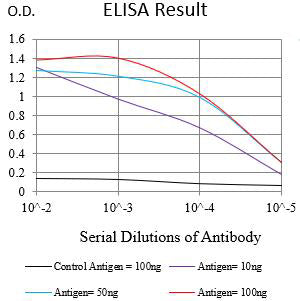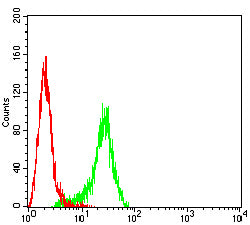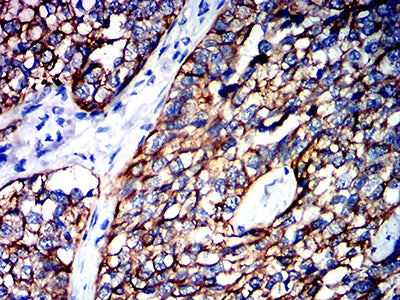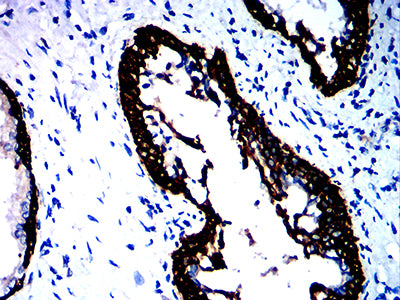





| WB | 1/500 - 1/2000 | Human,Mouse,Rat |
| IF | 咨询技术 | Human,Mouse,Rat |
| IHC | 1/200 - 1/1000 | Human,Mouse,Rat |
| ICC | 技术咨询 | Human,Mouse,Rat |
| FCM | 1/200 - 1/400 | Human,Mouse,Rat |
| Elisa | 1/10000 | Human,Mouse,Rat |
| Aliases | K15; CK15; K1CO |
| Entrez GeneID | 3866 |
| clone | 1B6A9 |
| WB Predicted band size | 49.2Kda |
| Host/Isotype | Mouse IgG1 |
| Antibody Type | Primary antibody |
| Storage | Store at 4°C short term. Aliquot and store at -20°C long term. Avoid freeze/thaw cycles. |
| Species Reactivity | Human |
| Immunogen | Purified recombinant fragment of human KRT15 (AA: 105-456) expressed in E. Coli. |
| Formulation | Purified antibody in PBS with 0.05% sodium azide |
+ +
以下是关于KRT15抗体的3篇代表性文献及其摘要内容的简要概括:
---
1. **文献名称**:*KRT15 Expression in Epidermal Stem Cells: A Key Marker for Skin Regeneration*
**作者**:Blanpain, C. et al.
**摘要**:该研究通过KRT15抗体标记小鼠表皮基底层的干细胞,发现KRT15阳性细胞具有长期自我更新能力和分化潜能,证实其在皮肤损伤修复中的关键作用。
---
2. **文献名称**:*KRT15+ Cells Drive Tumor Initiation in Head and Neck Squamous Cell Carcinoma*
**作者**:Bienkó, M. et al.
**摘要**:利用KRT15抗体鉴定头颈部鳞癌中的肿瘤起始细胞,发现KRT15高表达细胞具有更强的致瘤性和化疗耐药性,提示其作为治疗靶点的潜力。
---
3. **文献名称**:*KRT15 as a Marker for Hair Follicle Stem Cell Niches*
**作者**:Morris, R.J. et al.
**摘要**:研究通过KRT15抗体定位毛囊隆突区的干细胞群,证实其在毛囊周期性再生中的核心地位,并揭示其与Wnt信号通路的调控关联。
---
如需具体文献来源(期刊、年份等),可进一步补充检索条件(如研究领域或时间范围)。
Keratin 15 (KRT15) is a type I intermediate filament protein encoded by the *KRT15* gene, primarily expressed in the basal layer of stratified epithelia, including the epidermis, hair follicles, and other specialized epithelial tissues. As a key structural component, it contributes to cellular integrity, mechanical stability, and stress resistance. KRT15 is notably enriched in epithelial stem cells or progenitor cells, serving as a potential marker for identifying and isolating these cells in research contexts, particularly in skin biology and regenerative medicine.
Antibodies targeting KRT15 are valuable tools in both basic and clinical research. They enable the visualization and quantification of KRT15 expression via techniques like immunohistochemistry (IHC), immunofluorescence (IF), and Western blotting. These antibodies help delineate the spatial distribution of KRT15-positive cells within tissues, aiding studies on epithelial differentiation, wound healing, and stem cell dynamics. Clinically, altered KRT15 expression has been implicated in conditions such as skin cancers (e.g., squamous cell carcinoma), alopecia, and certain blistering disorders. KRT15 antibodies thus assist in diagnostic profiling and exploring disease mechanisms.
Recent studies also highlight KRT15's role in tumor initiation and resistance to therapy, linking it to cancer stem cell populations. However, its regulatory pathways and interactions remain under investigation. Commercially available KRT15 antibodies vary in specificity and host species, requiring validation for experimental reproducibility. Overall, KRT15 antibodies remain pivotal in advancing epithelial biology research and translational applications.
×